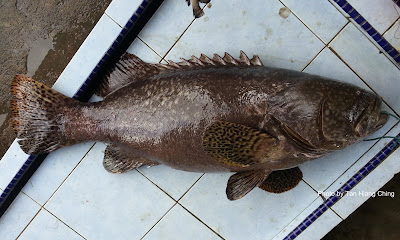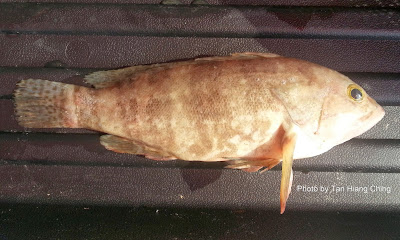The name "grouper" comes from the Portuguese name "garoupa" for the fish. In Malaysia and Indonesia, it is called "kerapu" which is also believed to come from the word "garoupa". Contrary to their name which suggests the fish stays in group, they are actually the solitary type. Unlike snappers which move in groups, they are intolerant of the same species or other similar fishes. Most species gather together in pairs or aggregations only for spawning. Many species are hermaphrodites, meaning that they can change their sex. They start out as females and change to male at a later stage.
Typical groupers have a stout body and a large mouth. They do not have many teeth on the edges of their jaws, but they have heavy crushing tooth palates inside they pharynx. Their mouth and gills form a powerful sucking system that can suck their prey in from a distance. They habitually eat fish, squid, and crustacean. They swallow prey rather than biting pieces of it and that makes them easy to get hook by bait. Normally a squid bait can be used over and over again.
Their coloration and ability to change hues and shades to blend in with their surroundings allow them to camouflage and lie in wait for prey rather than chasing in open water. They will ambush, dash and strike the prey in short distance. Right after they suck the bait, they will normally go into the rocks or structure that is surrounding them. When threatened, they use their mouth to expand their gill covers digging them into rock cave sides to form their shelters. Their gill muscles are so powerful that it is very difficult to pull them out of a cave.
There are 64 genera and approximately 475 species worldwide. Malaysia is represented by 15 genera and approximately 68 species.
Groupers are abundant in Tanjung Leman. They can be easily caught by bottom line fishing and bubu (local fish trap). Species of grouper found in Tanjung Leman are as follows:
Grouper Species:
Scientific Name: Cephalopholis boenak (Bloch, 1790)
English Name: Chocolate Hind, Brown-barred Grouper
Mandarin Name: 石斑魚 (Shí bān yú), 印度石斑 (Yìndù shí bān)
Local Malay Name: Kerapu Tenggarong, Kerapu Belang Perang
Main Diagnostic Features: Body brown, with 7 or 8 more or less distinct dark bars. Fins dark brown, with a pale blue line at corners of caudal fin.
Size: Maximum total length 30 cm.

Scientific Name: Cephalopholis formosa (Shaw, 1812)
English Name: Bluelined Grouper, Bluelined Hind, Bluelined Rockcod
Mandarin Name: 石斑魚 (Shí bān yú), 蓝线石斑 (Lán xiàn shí bān)
Local Malay Name: Ikan Kerapu Garis Biru
Local Hokkien: Thee Swa Gau
Local Teochew: Gao Hu
Local Cantonese: Seck Pan
Main Diagnostic Features: Colour generally brown or yellowish brown, with dark blue lines on head, body, and fins. Black spot between upper 2 opercular spines.
Size: Maximum total length 34 cm.
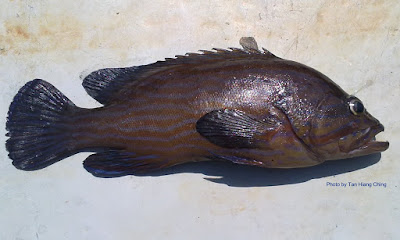
Scientific Name: Cephalopholis cyanostigma (Valenciennes, 1828)
English Name: Bluespotted Hind
Mandarin Name: 石斑魚 (Shí bān yú)
Local Malay Name: Kerapu Bintik Biru, Kerapu Karang
Main Diagnostic Features: Blue ocelli on head, body, and basally on median fins.
Size: Maximum total length at 40 cm.
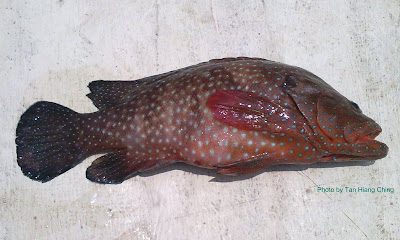
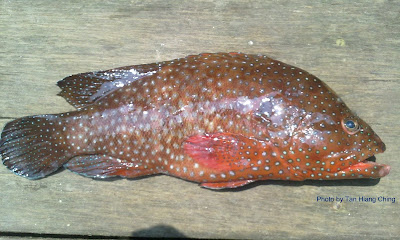
Scientific Name: Diploprion bifasciatum Cuvier, 1828
Mandarin Name: 肥皂鱼 (Féizào yú)
Local Malay Name: Kerapu Sebekah, Sebekah Laut
Main Diagnostic Features: Body compressed with yellow colour posterior.
Size: Maximum total length 25 cm.
English Name: Areolate Grouper
Mandarin Name: 石斑魚 (Shí bān yú), 西星斑 (Xi xīng bān)
Local Malay Name: Kerapu Ekor Putih, Kerapu Bintik Bulat
Local Hokkien: Koay Gau
Local Teochew: Gao Hu
Local Cantonese: Seck PanMain Diagnostic Features: Head, body, and fins covered with numerous close-set brown, brownish yellow or greenish yellow spots. Posterior edge of caudal fin with a distinct white margin.
Size: Maximum total length about 40 cm.
Scientific Name: Epinephelus bleekeri (Vaillant, 1878)
English Name: Duskytail Grouper
French Name: Mérou demideui
Mandarin Name: 石斑魚 (Shí bān yú), 红点油班 (Hóng diǎn yóu bān)
Local Malay Name: Ikan Kerapu Ekor Gelap
Local Hokkien: Koay Gau
Local Teochew: Gao Hu
Local Cantonese: Seck Pan
Main Diagnostic Features: Dorsal fin and upper third of caudal fin with spots like those on body. Lower two-thirds of caudal fin dusky.
Size: Maximum total length about 76 cm.
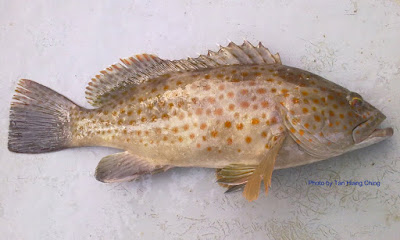
Scientific Name: Epinephelus coioides (Hamilton, 1822)
English Name: Orange-spotted Grouper, Goldspotted Rockcod, Brownspotted Grouper, Estuary Cod
French Name: Mérou taches oranges
Mandarin Name: 石斑魚 (Shí bān yú), 红点石斑 (Hóng diǎn shí bān)
Local Malay Name: Ikan Kerapu bintik jingga, Kerapu Pinang, Kerapu Balong, Kerapu Rintek, Kerapu Pakpanang
Local Hokkien: Chia Gau
Main Diagnostic Features: Numerous small brownish orange or reddish brown spots on head, body, and median fins. Body with 5 faint, irregular, oblique, dark bars. Caudal fin not dusky.
Size: Maximum length at least 95 cm.
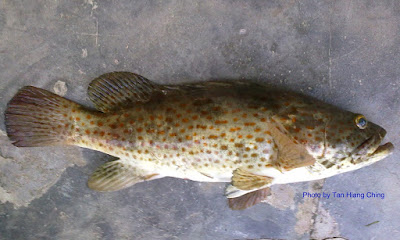
Scientific Name: Epinephelus corallicola (Valenciennes, 1828)
English Name: Coral Grouper
French Name: Mérou corail
Mandarin Name: 石斑魚 (Shí bān yú)
Local Malay Name: Ikan Kerapu Karang, Kerapu Pisang
Main Diagnostic Features: Grey in colour, with well-separated black spots smaller than pupil on head, body and fins. 3 dusky to blackish blotches on body at base of rear half of dorsal fin. Dusky to blackish saddle spot on caudal peduncle.
Size: Maximum total length about 49 cm.
Scientific Name: Epinephelus erythrurus (Valenciennes, 1828)
English Name: Cloudy Grouper, Cloudy Rockcod, Garoupa
Mandarin Name: 石斑魚 (Shí bān yú), 石头斑 (Shítou bān)
Local Malay Name: Ikan Kerapu Tompok Awan, Kerapu Combat
Local Hokkien: Koay Gau
Local Teochew: Gao Hu
Local Cantonese: Seck Pan
Main Diagnostic Features: Body with white and brown patches that form many cloud like pattern.
Size: Maximum total length about 45 cm.

Scientific Name: Epinephelus fasciatomaculosus (Peters, 1865)
English Name: Rock Grouper, Red Banded Grouper
Mandarin Name: 石斑魚 (Shí bān yú), 青眼斑 (Qīng yǎn bān)
Local Malay Name: Ikan Kerapu Batu, Tongkah
Local Hokkien: Koay Gau, Gau Hu
Local Teochew: Gao Hu
Local Cantonese: Seck Pan
Main Diagnostic Features: 5 slightly oblique broad dark bars usually visible on body. The last bar covering peduncle and the first 4 extending into dorsal fin. The first 2 bars are darker dorsally and extend to the margin of spinous dorsal fin.
Size: Maximum total length about 30 cm.

Scientific Name: Epinephelus fasciatus (Forsskål, 1775)
English Name: Blacktip Grouper
Mandarin Name: 石斑魚 (Shí bān yú), 赤石斑鱼 (Chìshí bān yú)
Local Malay Name: Ikan Kerapu Sirip Hitam, Kerapu Merah
Main Diagnostic Features: The outer triangular part of interspinous membranes of dorsal fin black or dark red, with pale yellow or white spot behind tip of each spine.
Size: Maximum total length about 40 cm.
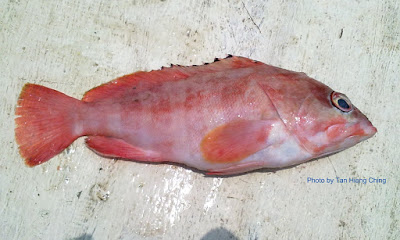
Scientific Name: Epinephelus lanceolatus (Bloch, 1790)
English Name: Giant Grouper, Brindlebass, Brown Spotted Cod, Bumblebee Grouper, Queensland Groper
Mandarin Name: 石斑魚 (Shí bān yú), 鞍帶石斑魚(Ān dài shí bān yú), 龙旦 (Lóng dàn)
Local Malay Name:Ikan Kertang, Kerapu Pertang
Local Cantonese: Long Tan
Main Diagnostic Features: Fins (most visible on pectoral fin) with numerous small black spots. Body colour vary from juvenile to adult.
Size: One of the largest groupers, attains 270 cm total length. Maximum weight 400 kg.
Scientific Name: Epinephelus quoyanus (Valenciennes, 1830)
English Name: Longfin Grouper
Mandarin Name: 石斑魚 (Shí bān yú), 蜜蜂斑 (Mìfēng bān)
Local Malay Name:Ikan Kerapu Cicak, Kerapu Tukul
Local Teochew: Gao Hu
Local Cantonese: Seck Pan
Main Diagnostic Features: Large, close-set, hexagonal to roundish, dark brown to blackish spots. Ventral edge of anal and caudal fins and leading edge of pelvic fins with white line and blackish submarginal band.
Size: Maximum total length 40 cm.
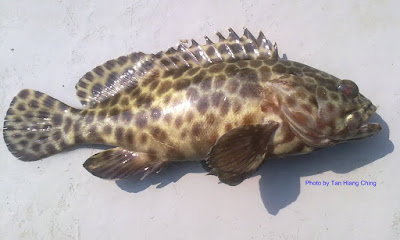
Scientific Name: Epinephelus sexfasciatus (Valenciennes, 1828)
English Name: Sixbar Grouper, Garoupa
Mandarin Name: 石斑魚 (Shí bān yú), 糯米石斑 (Nuòmǐ shí bān)
Local Malay Name: Ikan Kerapu Bebeh
Local Hokkien: Koay Gau
Local Teochew: Gao Hu
Local Cantonese: Seck Pan
Main Diagnostic Features: Body pale to dark brown with 5 dark brown bars on body and 1 on nape. Relatively large dark spots on dorsal, anal and caudal fins.
Size: Maximum total length 28 cm.
French Name: Mérou corail
Mandarin Name: 石斑魚 (Shí bān yú)
Local Malay Name: Ikan Kerapu Karang, Kerapu Pisang
Main Diagnostic Features: Grey in colour, with well-separated black spots smaller than pupil on head, body and fins. 3 dusky to blackish blotches on body at base of rear half of dorsal fin. Dusky to blackish saddle spot on caudal peduncle.
Size: Maximum total length about 49 cm.
Scientific Name: Epinephelus erythrurus (Valenciennes, 1828)
English Name: Cloudy Grouper, Cloudy Rockcod, Garoupa
Mandarin Name: 石斑魚 (Shí bān yú), 石头斑 (Shítou bān)
Local Malay Name: Ikan Kerapu Tompok Awan, Kerapu Combat
Local Hokkien: Koay Gau
Local Teochew: Gao Hu
Local Cantonese: Seck Pan
Main Diagnostic Features: Body with white and brown patches that form many cloud like pattern.
Size: Maximum total length about 45 cm.

Scientific Name: Epinephelus fasciatomaculosus (Peters, 1865)
English Name: Rock Grouper, Red Banded Grouper
Mandarin Name: 石斑魚 (Shí bān yú), 青眼斑 (Qīng yǎn bān)
Local Malay Name: Ikan Kerapu Batu, Tongkah
Local Hokkien: Koay Gau, Gau Hu
Local Teochew: Gao Hu
Local Cantonese: Seck Pan
Main Diagnostic Features: 5 slightly oblique broad dark bars usually visible on body. The last bar covering peduncle and the first 4 extending into dorsal fin. The first 2 bars are darker dorsally and extend to the margin of spinous dorsal fin.
Size: Maximum total length about 30 cm.

Scientific Name: Epinephelus fasciatus (Forsskål, 1775)
English Name: Blacktip Grouper
Mandarin Name: 石斑魚 (Shí bān yú), 赤石斑鱼 (Chìshí bān yú)
Local Malay Name: Ikan Kerapu Sirip Hitam, Kerapu Merah
Main Diagnostic Features: The outer triangular part of interspinous membranes of dorsal fin black or dark red, with pale yellow or white spot behind tip of each spine.
Size: Maximum total length about 40 cm.

Scientific Name: Epinephelus lanceolatus (Bloch, 1790)
English Name: Giant Grouper, Brindlebass, Brown Spotted Cod, Bumblebee Grouper, Queensland Groper
Mandarin Name: 石斑魚 (Shí bān yú), 鞍帶石斑魚(Ān dài shí bān yú), 龙旦 (Lóng dàn)
Local Malay Name:Ikan Kertang, Kerapu Pertang
Local Cantonese: Long Tan
Main Diagnostic Features: Fins (most visible on pectoral fin) with numerous small black spots. Body colour vary from juvenile to adult.
Size: One of the largest groupers, attains 270 cm total length. Maximum weight 400 kg.
Scientific Name: Epinephelus quoyanus (Valenciennes, 1830)
Mandarin Name: 石斑魚 (Shí bān yú), 蜜蜂斑 (Mìfēng bān)
Local Malay Name:Ikan Kerapu Cicak, Kerapu Tukul
Local Teochew: Gao Hu
Local Cantonese: Seck Pan
Main Diagnostic Features: Large, close-set, hexagonal to roundish, dark brown to blackish spots. Ventral edge of anal and caudal fins and leading edge of pelvic fins with white line and blackish submarginal band.
Size: Maximum total length 40 cm.

Scientific Name: Epinephelus sexfasciatus (Valenciennes, 1828)
Mandarin Name: 石斑魚 (Shí bān yú), 糯米石斑 (Nuòmǐ shí bān)
Local Malay Name: Ikan Kerapu Bebeh
Local Hokkien: Koay Gau
Local Teochew: Gao Hu
Local Cantonese: Seck Pan
Main Diagnostic Features: Body pale to dark brown with 5 dark brown bars on body and 1 on nape. Relatively large dark spots on dorsal, anal and caudal fins.
Size: Maximum total length 28 cm.
Scientific Name: Plectropomus leopardus (Lacepède, 1802)
English Name: Common Coral Trout, Leopard Trout, Leopard Coral Grouper
Mandarin Name: 石斑魚 (Shí bān yú), 七星斑 (Qī xīng bān)
Local Malay Name: Kerapu Sunoh Bara, Kerapu Bintang
Local Hokkien: Ang Gau
Main Diagnostic Features: Body covered in a profusion of small blue dots. Pectoral fin transparent and without blue dots. Distinctive blue ring around the eye.
Size: Maximum standard length 120 cm, commonly 35 cm.
Scientific Name: Plectropomus maculatus (Bloch, 1790)
Mandarin Name: 石斑魚 (Shí bān yú), 东星斑 (Dōng xīng bān)
Local Malay Name: Ikan Kerapu sunoh pisang, Kerapu Bara
Local Hokkien: Chut Bee Gau, Ang Gau
Main Diagnostic Features: Head, body, and median fins greenish grey, brown, red, or orange-red, with dark-edged blue spots. Spots on head and anterior part of body oval or horizontally elongated. The spots become much smaller, more uniformly round, and more numerous on rear part of body and on fins.
Size: Maximum total length about 125 cm


Scientific Name: Variola albimarginata Baissac, 1953
English Name: White-edged Lyretail, White-edged Lunartail
Mandarin Name: 石斑魚 (Shí bān yú), 白缘星鲙 (Bái yuán xīng kuài)
Local Malay Name: Kerapu Sabit Putih
Main Diagnostic Features: Caudal fin lunate. Margin of caudal fin with a narrow white edge.
Size: Maximum total length 47 cm.

Nutritional Facts for Grouper:
Item: Fish, grouper, mixed species, raw
Item: Fish, grouper, mixed species, raw
Refuse: 0%
Scientific Name: Epinephelus spp.
NDB No: 15031 (Nutrient values and weights are for edible portion)
Source: USDA National Nutrient Database for Standard Reference, Release 24 (2011)
References:
Scientific Name: Epinephelus spp.
NDB No: 15031 (Nutrient values and weights are for edible portion)
| Nutrient | Units | Value per 100 grams | Number of Data Points | Std. Error |
|---|---|---|---|---|
| Proximates | ||||
| Water |
g
|
79.22
|
6
|
0.478
|
| Energy |
kcal
|
92
|
0
|
0.000
|
| Energy |
kJ
|
385
|
0
|
0.000
|
| Protein |
g
|
19.38
|
6
|
0.457
|
| Total lipid (fat) |
g
|
1.02
|
7
|
0.000
|
| Ash |
g
|
1.17
|
5
|
0.014
|
| Carbohydrate, by difference |
g
|
0.00
|
0
|
0.000
|
| Fiber, total dietary |
g
|
0.0
|
0
|
0.000
|
| Minerals | ||||
| Calcium, Ca |
mg
|
27
|
5
|
4.075
|
| Iron, Fe |
mg
|
0.89
|
5
|
0.015
|
| Magnesium, Mg |
mg
|
31
|
3
|
0.580
|
| Phosphorus, P |
mg
|
162
|
5
|
0.000
|
| Potassium, K |
mg
|
483
|
3
|
9.220
|
| Sodium, Na |
mg
|
53
|
4
|
9.409
|
| Zinc, Zn |
mg
|
0.48
|
51
|
0.030
|
| Copper, Cu |
mg
|
0.020
|
52
|
0.002
|
| Manganese, Mn |
mg
|
0.014
|
3
|
0.001
|
| Selenium, Se |
µg
|
36.5
|
0
|
0.000
|
| Vitamins | ||||
| Vitamin C, total ascorbic acid |
mg
|
0.0
|
0
|
0.000
|
| Thiamin |
mg
|
0.070
|
2
|
0.000
|
| Riboflavin |
mg
|
0.005
|
2
|
0.000
|
| Niacin |
mg
|
0.313
|
1
|
0.000
|
| Pantothenic acid |
mg
|
0.750
|
0
|
0.000
|
| Vitamin B-6 |
mg
|
0.300
|
0
|
0.000
|
| Folate, total |
µg
|
9
|
0
|
0.000
|
| Folic acid |
µg
|
0
|
0
|
0.000
|
| Folate, food |
µg
|
9
|
0
|
0.000
|
| Folate, DFE |
µg_DFE
|
9
|
0
|
0.000
|
| Vitamin B-12 |
µg
|
0.60
|
2
|
0.000
|
| Vitamin A, RAE |
µg_RAE
|
43
|
0
|
0.000
|
| Retinol |
µg
|
43
|
0
|
0.000
|
| Vitamin A, IU |
IU
|
143
|
0
|
0.000
|
| Lipids | ||||
| Fatty acids, total saturated |
g
|
0.233
|
0
|
0.000
|
| 4:0 |
g
|
0.000
|
0
|
0.000
|
| 6:0 |
g
|
0.000
|
0
|
0.000
|
| 8:0 |
g
|
0.000
|
0
|
0.000
|
| 10:0 |
g
|
0.000
|
0
|
0.000
|
| 12:0 |
g
|
0.000
|
0
|
0.000
|
| 14:0 |
g
|
0.012
|
2
|
0.000
|
| 16:0 |
g
|
0.169
|
2
|
0.000
|
| 18:0 |
g
|
0.049
|
2
|
0.000
|
| Fatty acids, total monounsaturated |
g
|
0.202
|
0
|
0.000
|
| 16:1 undifferentiated |
g
|
0.027
|
2
|
0.000
|
| 18:1 undifferentiated |
g
|
0.145
|
2
|
0.000
|
| 20:1 |
g
|
0.029
|
1
|
0.000
|
| 22:1 undifferentiated |
g
|
0.007
|
1
|
0.000
|
| Fatty acids, total polyunsaturated |
g
|
0.321
|
0
|
0.000
|
| 18:2 undifferentiated |
g
|
0.012
|
2
|
0.000
|
| 18:3 undifferentiated |
g
|
0.010
|
1
|
0.000
|
| 18:4 |
g
|
0.000
|
0
|
0.000
|
| 20:4 undifferentiated |
g
|
0.033
|
2
|
0.000
|
| 20:5 n-3 (EPA) |
g
|
0.027
|
2
|
0.000
|
| 22:5 n-3 (DPA) |
g
|
0.010
|
2
|
0.000
|
| 22:6 n-3 (DHA) |
g
|
0.220
|
2
|
0.000
|
| Cholesterol |
mg
|
37
|
2
|
0.000
|
| Amino acids | ||||
| Tryptophan |
g
|
0.217
|
0
|
0.000
|
| Threonine |
g
|
0.849
|
0
|
0.000
|
| Isoleucine |
g
|
0.893
|
0
|
0.000
|
| Leucine |
g
|
1.575
|
0
|
0.000
|
| Lysine |
g
|
1.779
|
0
|
0.000
|
| Methionine |
g
|
0.574
|
0
|
0.000
|
| Cystine |
g
|
0.208
|
0
|
0.000
|
| Phenylalanine |
g
|
0.756
|
0
|
0.000
|
| Tyrosine |
g
|
0.654
|
0
|
0.000
|
| Valine |
g
|
0.998
|
0
|
0.000
|
| Arginine |
g
|
1.159
|
0
|
0.000
|
| Histidine |
g
|
0.570
|
0
|
0.000
|
| Alanine |
g
|
1.172
|
0
|
0.000
|
| Aspartic acid |
g
|
1.984
|
0
|
0.000
|
| Glutamic acid |
g
|
2.892
|
0
|
0.000
|
| Glycine |
g
|
0.930
|
0
|
0.000
|
| Proline |
g
|
0.685
|
0
|
0.000
|
| Serine |
g
|
0.791
|
0
|
0.000
|
| Other | ||||
| Alcohol, ethyl |
g
|
0.0
|
0
|
0.000
|
Source: USDA National Nutrient Database for Standard Reference, Release 24 (2011)
References:
Heemstra. P.C. (2002). Perciformes: Percoidei: Serranidae in: Carpenter, K.E. (ed.). THE LIVING MARINE RESOURCES OF THE WESTERN CENTRAL ATLANTIC Volume 2 Bony fishes part 1 (Acipenseridae to Grammatidae). Rome, FAO. 2002. pp.1308-1369
Mohd Azmi Ambak, Mansor Mat Isa, Mohd Zaidi Zakaria and Mazlan Abd Ghaffar (2010) Fishes of Malaysia. Universiti Malaysia Trengganu, Malaysia. Penerbit UMT.
Family Serranidae - Sea basses: groupers and fairy basslets. Fishbase. Available at:
Mohd Azmi Ambak, Mansor Mat Isa, Mohd Zaidi Zakaria and Mazlan Abd Ghaffar (2010) Fishes of Malaysia. Universiti Malaysia Trengganu, Malaysia. Penerbit UMT.
Family Serranidae - Sea basses: groupers and fairy basslets. Fishbase. Available at:
http://www.fishbase.org/Summary/FamilySummary.php?ID=289
USDA National Nutrient Database for Standard Reference. USDA. Available at http://www.nal.usda.gov
USDA National Nutrient Database for Standard Reference. USDA. Available at http://www.nal.usda.gov



